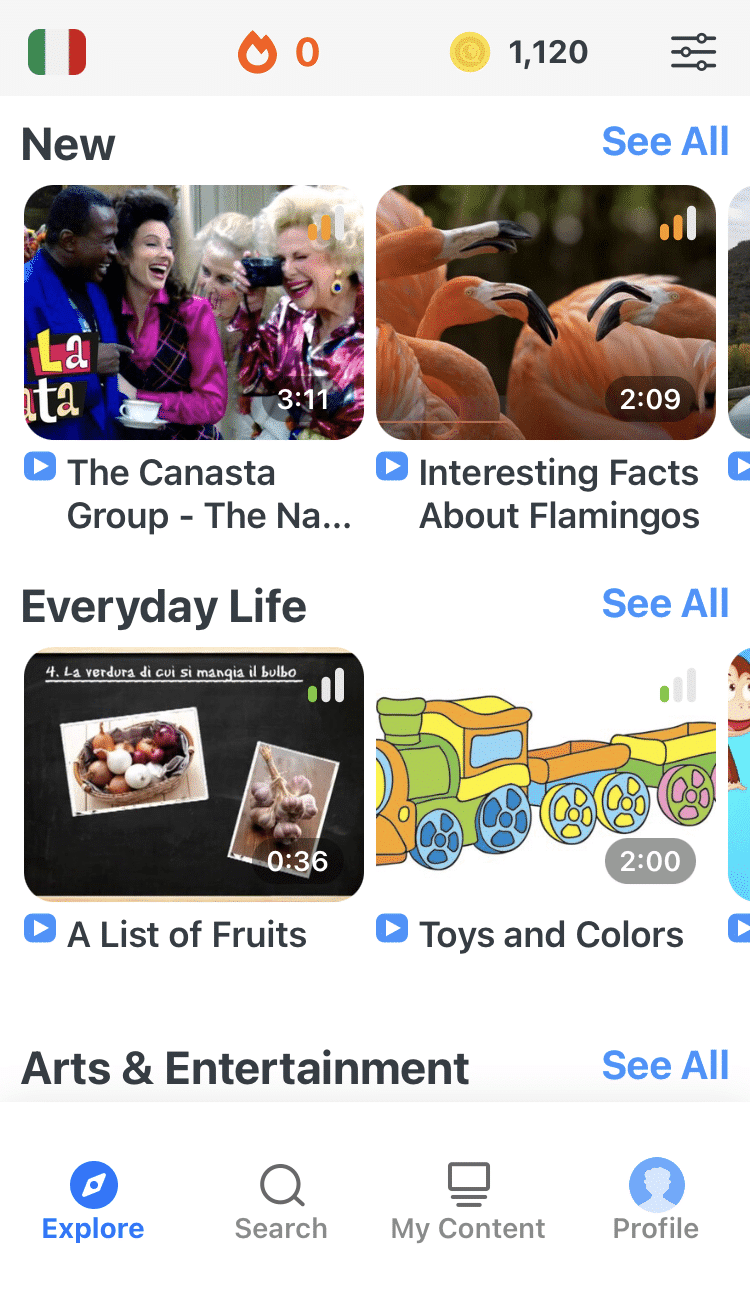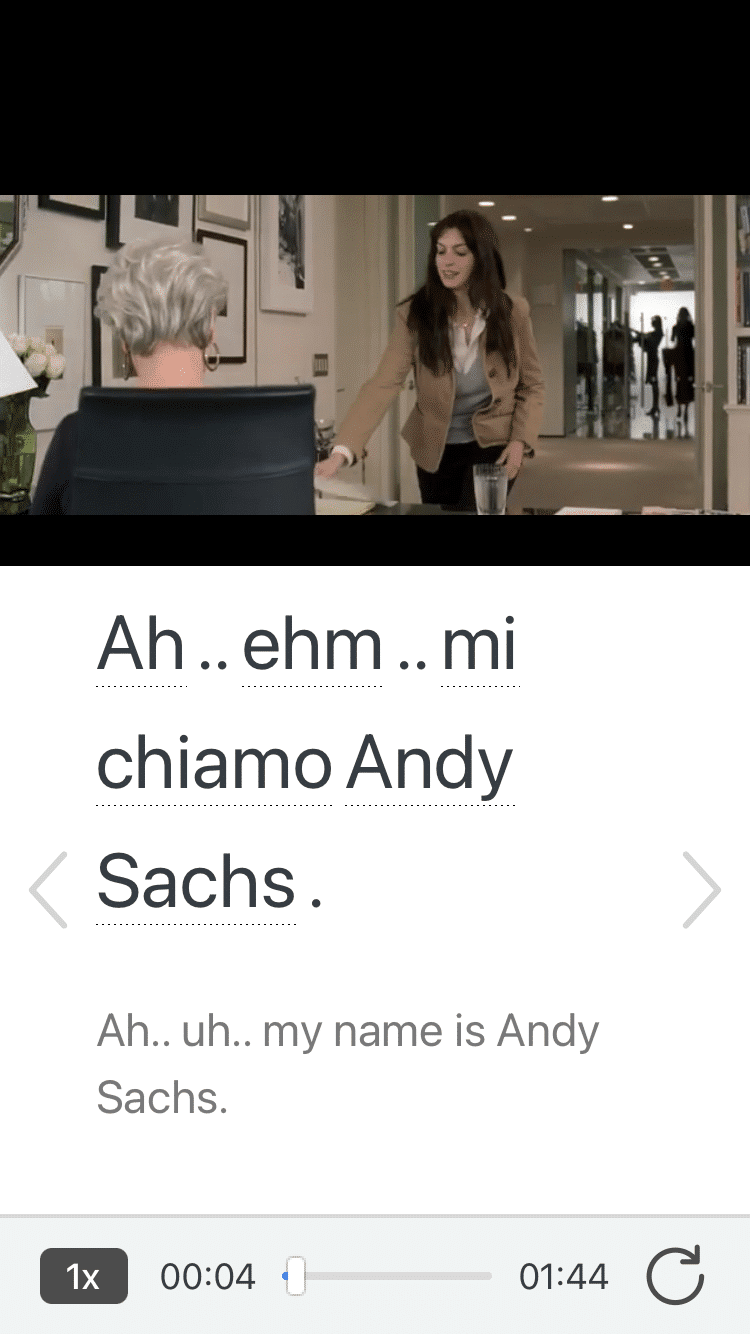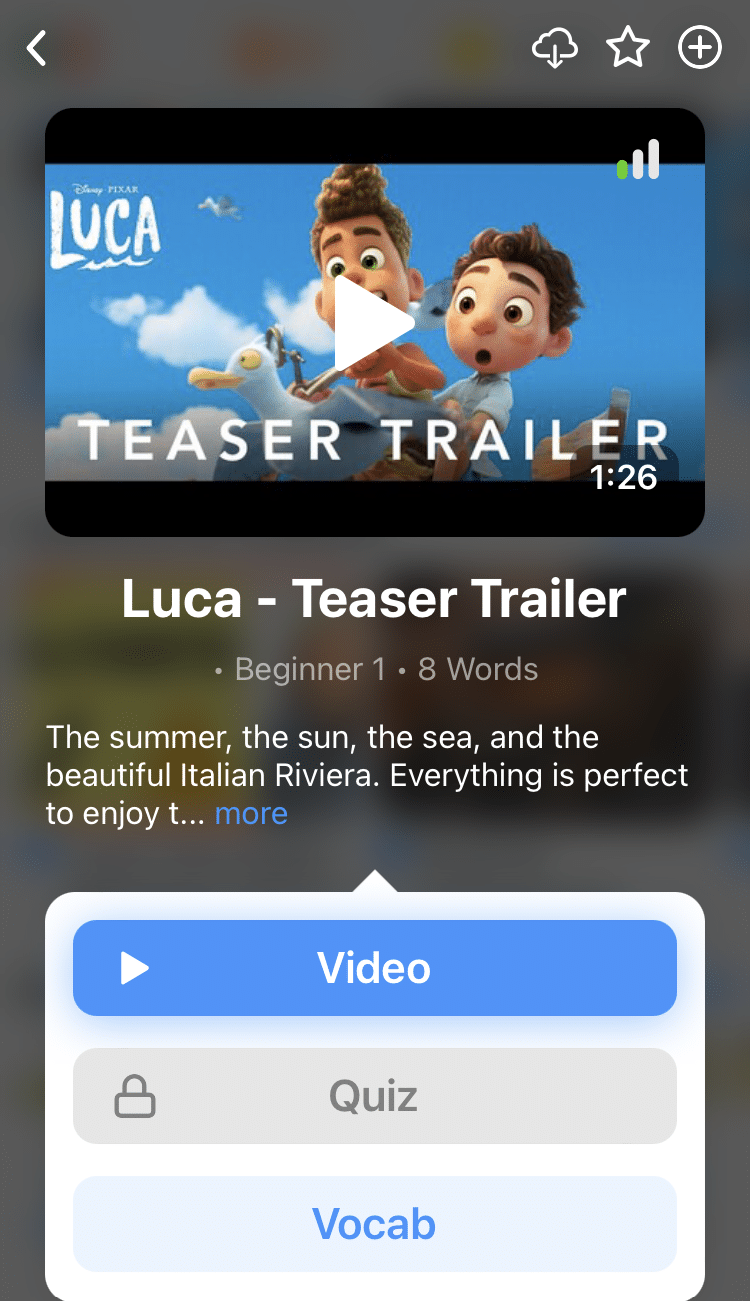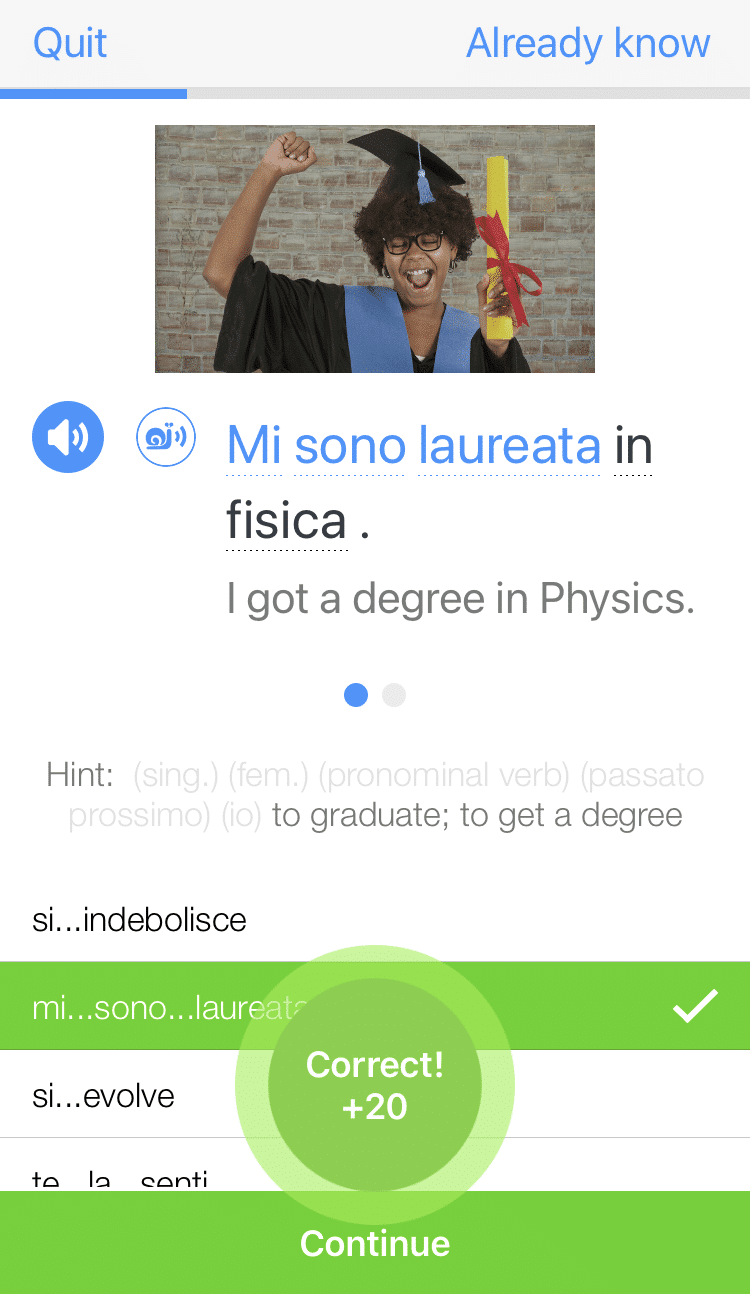
Italian Pronouns
Leonardo da Vinci once said that “simplicity is the ultimate sophistication.”
But what does simplicity really mean?
In the case of Italian nouns, it means replacing nouns with pronouns to make our sentences crisp and concise.
This post will take a look at three types of Italian pronouns: subject, direct object and indirect object, so let’s dive in!
Contents
- Italian Subject Pronouns
- Italian Direct Object Pronouns
- Italian Indirect Object Pronouns
- Where to Practice Italian Pronouns
- And One More Thing...
Download: This blog post is available as a convenient and portable PDF that you can take anywhere. Click here to get a copy. (Download)
Italian Subject Pronouns
The subject pronoun in a sentence replaces the subject, or the “doer,” of the sentence. This is often the noun that is performing the verb.
For example, in the sentence “Io vado al cinema” (I go to the movies), Io (I) is the subject pronoun because it is doing the action of going to the movies.
There are seven subject pronouns in Italian:
| Italian | English | Example |
|---|---|---|
| Io | I | Io mangio il cibo. (I eat the food.) |
| Tu | You (informal) | Tu sei un ragazzo. (You are a boy.) |
| Lui | He | Lui parla italiano. (He speaks Italian.) |
| Lei | She/You (formal) | Lei vuole andare al negozio. (She wants to go to the store.) |
| Noi | We | Noi cantiamo. (We sing.) |
| Voi | You (plural) | Voi potete venire alle 7. (You all can come at 7.) |
| Loro | They | Loro ballano. (They dance.) |
In addition to being able to replace people, lui, lei and loro can also be used to mean “it” or “they” in order to replace animals and things.
Lui replaces a masculine, singular noun as in:
Lui (il cane) è bianco.
It [the dog] is white.
Lei replaces a feminine, singular noun as in:
Lei (la macchina) è veloce.
It [the car] is fast.
And loro replaces a plural noun as in:
Loro (i ragazzi) fanno i compiti.
They [the kids] do their homework.
Additionally, the pronoun Lei is used to mean “you” in formal situations (when used in this way, it is always written with a capital letter). For example, when speaking formally, one could say:
Lei va con noi?
Are you [formal] coming with us?
Lastly, Italian is also a language that allows speakers to drop the subject pronoun.
For example, instead of saying, “Tu vedi il libro” (You see the book), you can simply say, “Vedi il libro.”
This dropping is heavily dependent on context, so be sure this is clear before dropping a subject pronoun from the sentence.
Italian Direct Object Pronouns
In addition to subject pronouns, Italian also has pronouns for direct objects: nouns that get acted upon by the verb.
For example, in the sentence “bevo il caffè” (I drink coffee), il caffè is the direct object because it is the noun being impacted by the action of the verb (the drinking).
In Italian, there are two types of direct object pronouns:
- Unaccented pronouns go before the verb
- Accented pronouns go after the verb
Depending on their positions (before or after the verb), these unaccented and accented pronouns have slightly different forms.
As with subject pronouns, the direct objects lo, la and li can replace both people and objects.
Check out these examples of unaccented direct objects:
| Italian | English | Example |
|---|---|---|
| Mi | Me | Lui mi ha colpito. (He hit me.) |
| Ti | You | Io ti amo. (I love you.) |
| Lo | Him/It | Tu lo troverai nel cassetto. (You will find it in the drawer.) |
| La | Her/It | Io la porterò al negozio. (I will take her to the store.) |
| Ci | Us | Loro ci visitano. (They are visiting us.) |
| Vi | You all | Io vi saluto. (I greet you all.) |
| Li/Le | Them (masc./fem.) | Luigi li finisce. (Luigi is finishing them.) |
Keep in mind that the unaccented direct pronouns mi, ti, lo and la can be shortened to m’, t’ and l’ before a vowel or before an h-:
Lui m’ha colpito.
(He hit me.)
Io t’amo.
(I love you.)
Tu l’hai trovato nel cassetto.
(You found it in the drawer.)
Io l’ho portata al negozio.
(I took her to the store.)
Note that when using a direct object pronoun with a compound verb, the last letter of the past participle must agree in gender and number to that of the direct object pronoun.
For instance:
Li ho letti.
(I read them.)
Le ho lette ieri.
(I read them yesterday.)
Conversely, accented direct objects come after the noun. Let’s look at the sentences above again with accented pronouns:
| Italian | English | Example |
|---|---|---|
| Mi | Me | Lui ha colpito me. (He hit me.) |
| Ti | You | Io amo te. (I love you.) |
| Lui | Him/It | Tu troverai lui nel cassetto. (You will find it in the drawer.) |
| Lei | Her/It | Io porterò lei al negozio. (I will take her to the store.) |
| Noi | Us | Loro visitano noi. (They are visiting us.) |
| Voi | You all | Io saluto voi. (I greet you all.) |
| Loro | Them | Luigi finisce loro. (Luigi is finishing them.) |
Italian Indirect Object Pronouns
Indirect objects are nouns that are the receiver of the verb’s action.
For example, in the sentence “Do il vino a Maria” (I’m giving the wine to Maria), Maria is the indirect object because she is receiving the action of the verb.
Often, indirect objects are preceded by prepositions such as a (to).
Like direct objects, there are also two types of indirect object pronouns:
- Unaccented pronouns go before the verb
- Accented pronouns go after the verb with the preposition a (to)
Check out these unaccented indirect objects:
| Italian | English | Example |
|---|---|---|
| Mi | Me | Il professore mi dà i compiti. (The teacher gives me homework.) |
| Ti | You | Io ti scrivo ogni settimana. (I write to you each week.) |
| Gli | Him/It | Il cameriere gli dice che non ha il vino bianco. (The waiter tells him that he doesn't have white wine.) |
| Le | Her/It | Sua madre le ha telefonato. (Her mother called her.) |
| Ci | Us | Non ci hanno mandato un messaggio. (They didn't send us a message.) |
| Vi | You all | Lei vi ha letto il libro. (She read the book to you all.) |
| Gli | Them | Lo studente gli ha insegnato una nuova parola. (The student taught them a new word.) |
Unlike direct object pronouns, none of the indirect object pronouns shorten before a vowel or an h-.
Now, let’s check out those sentences again with accented indirect object pronouns that come after the verb. Note that each of these includes the preposition a (to):
| Italian | English | Example |
|---|---|---|
| A me | To me | Il professore da i compiti a me. (The teacher gives me homework.) |
| A te | To you | Io scrivo a te ogni settimana. (I write to you each week.) |
| A lui | To him/it | Il cameriere dice a lui che non ha il vino bianco. (The waiter tells him that he doesn't have white wine.) |
| A lei | To her/it | Sua madre ha telefonato a lei. (Her mother called her.) |
| A noi | To us | Non hanno mandato un messaggio a noi. (They didn't send us a message.) |
| A voi | To you all | Lei ha letto il libro a voi. (She read the book to you all.) |
| A loro | To them | Lo studente ha insegnato una nuova parola a loro. (The student taught them a new word.) |
Where to Practice Italian Pronouns
The best way to become efficient in using Italian pronouns is through practice. Here are some of the best resources you can use for your Italian pronoun practice:
- One World Italiano allows you to practice subject pronouns and direct object pronouns individually.
- Online Italian Club has some great exercises for direct object pronouns and indirect object pronouns.
- FluentU lets you hear pronouns used in everyday Italian speech.
FluentU takes authentic videos—like music videos, movie trailers, news and inspiring talks—and turns them into personalized language learning lessons.
You can try FluentU for free for 2 weeks. Check out the website or download the iOS app or Android app.
P.S. Click here to take advantage of our current sale! (Expires at the end of this month.)
When you’re ready to move on to the other types of pronouns in Italian, feel free to check out these other blog posts:
How to Use Italian Possessive Pronouns | FluentU Italian Blog
Italian possessive pronouns are an essential part of the language. After all, what’s mine is mine and what’s yours is yours! Or maybe you’re a great sharer and what’s…
12 Italian Relative Pronouns | FluentU Italian Blog
Italian relative pronouns can be just as hard (if not harder) to master as their English counterparts “that,” “which,” “who,” and “whom.” So how do you get them straight?…
Now you know how to use the most common Italian pronouns. Get ready to speak Italian as elegantly as da Vinci, Italian learner!
Download: This blog post is available as a convenient and portable PDF that you can take anywhere. Click here to get a copy. (Download)
And One More Thing...
If you're as busy as most of us, you don't always have time for lengthy language lessons. The solution? FluentU!
Learn Italian with funny commericals, documentary excerpts and web series, as you can see here:

FluentU helps you get comfortable with everyday Italian by combining all the benefits of complete immersion and native-level conversations with interactive subtitles. Tap on any word to instantly see an image, in-context definition, example sentences and other videos in which the word is used.

Access a complete interactive transcript of every video under the Dialogue tab, and review words and phrases with convenient audio clips under Vocab.

Once you've watched a video, you can use FluentU's quizzes to actively practice all the vocabulary in that video. Swipe left or right to see more examples of the word you’re on.

FluentU will even keep track of all the Italian words you’re learning, and give you extra practice with difficult words. Plus, it'll tell you exactly when it's time for review. Now that's a 100% personalized experience!
The best part? You can try FluentU for free with a trial.
Start using the FluentU website on your computer or tablet or, better yet, download the FluentU app from the iTunes or Google Play store. Click here to take advantage of our current sale! (Expires at the end of this month.)




